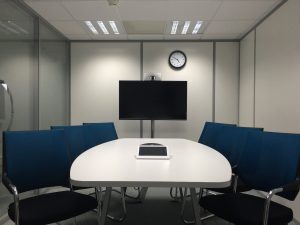I recently met with UVic Nursing Professor Dr. Debra Sheets. She has an exciting new project called Ease e-Home. She is working with geriatrician Dr. Marilyn Malone to use Amazon Echo in homes of people who have mild cognitive impairment. They are trialing it to see if using voice-controlled applications can help people stay connected to their family, engage in cognitive activities such as listening to music, and feel less socially isolated. Dr. Sheets’s work is a great example of leveraging an existing technology to improve the lives of people living with mild cognitive impairment.
This is an exciting time to be in nursing, as many innovative technologies promise to improve the patient experience and provide opportunities for improved interdisciplinary collaboration.
My background is in telemedicine. Telemedicine is two-way live videoconferencing. One concept I have been mulling over is to see how the School of Nursing can leverage telemedicine in practice education. In British Columbia the overall management of telemedicine is by the Provincial Health Services Authority. PHSA maintains an impressive number of telemedicine sites across the province. A great person to follow is Kathy Steegra, senior provincial executive director of Virtual Health, Trauma Services BC, and Mobile Medical Unit at PHSA, who posts updates of what the province is doing in the area of telemedicine.
I believe telemedicine can really benefit the nurse-practitioner program. For one, NP students have placements across BC. Our instructors will travel many miles this term doing site visits. Although site visits have been reported as an important element in NP education, the travel requirements are significant. Secondly, there is a universal challenge across BC and Canada in accessing enough primary-care placements. UVic is part of a provincial working group to address innovative ways to provide practice experiences.

Let’s talk about the idea of using telemedicine for direct observation of clinical competence, and enhancing practice education of NP students. There are two potential ways to do this.
1) Instructor remotely coaches a patient encounter via HIPPA-secure videoconferencing
The student is at the practice site with the consenting patient and connects using HIPPA-secure videoconferencing software with the instructor. The instructor is on their personal computer in a secure location. This would be similar to having a specialist videoconference into a patient encounter at a doctor’s office. In this case, however, the specialist—the practice instructor—starts by observing the patient-student encounter and interjects with questions if needed. Furthermore, once the patient encounter is completed, the student and instructor can debrief the encounter over video.
2) Students and instructors use tele-simulation to simulate a patient encounter
![]() Students in the UVIC NP program attend onsites, where one of the activities is to practice OSCEs. OSCEs are objective structured clinical exams. This is an opportunity for instructors to directly observe clinical competency and provide coaching and feedback. Some programs only use OSCEs as a measure of direct observation of clinical competency. Tele-simulation would place a standardized patient (or sim mannequin) and the instructor together, and the student would be at a distance (for example, in her home). The student would be presented with the case, and at a distance would lead the patient encounter. There is a lot of literature on tele-simulation in medicine. Toronto’s University Health Network has a centre dedicated to tele-simulation.
Students in the UVIC NP program attend onsites, where one of the activities is to practice OSCEs. OSCEs are objective structured clinical exams. This is an opportunity for instructors to directly observe clinical competency and provide coaching and feedback. Some programs only use OSCEs as a measure of direct observation of clinical competency. Tele-simulation would place a standardized patient (or sim mannequin) and the instructor together, and the student would be at a distance (for example, in her home). The student would be presented with the case, and at a distance would lead the patient encounter. There is a lot of literature on tele-simulation in medicine. Toronto’s University Health Network has a centre dedicated to tele-simulation.
There are so many great and innovative ideas out there, and we must critically evaluate their effectiveness. However, according to a recent report in the Journal of American Association of Nurse Practitioners, there is a belief that “telemedicine technology helps to solve the conundrum of clinical competency assessment and evaluation in online programs.”
We’d love to hear from you! Do you think these scenarios are feasible? Do you see any other benefits to using telemedicine? What about possible downsides?
Kambria Ernst is the practica coordinator at UVic and has over 10 years of experience implementing novel telemedicine applications at the University Health Network, Ontario Telemedicine Network and the University of Pittsburgh Medical Centre.
Conference-room photo from Pixabay, no other attribution. Blood-pressure photo by rawpixel on Unsplash.
Recent Comments